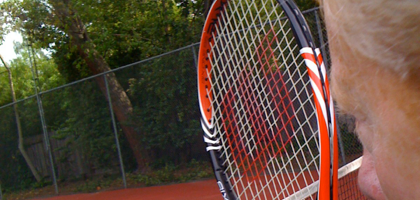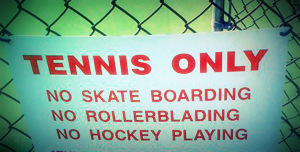 HOW DOES STRING THEORY ACTUALLY WORK?
HOW DOES STRING THEORY ACTUALLY WORK?
Simple. Let’s say you and your opponent are trading bombs from the baseline. Let’s also say you launch a line-to-line rocket that pushes them back two feet behind their baseline to respond. You don’t want the string to break, so move into the court two feet. Now you not only keep the right string tension and have a better chance to reach their shorter response shot, you also get a headstart on an approach shot and an at-the-net winner.
Or, let’s say a shallow mishit lets your opponent move into their court by three feet. What do you do? Let the theory be with you. Move back three feet and respond to their shot. (And don’t approach.) This is the guts of String Theory For Tennis (patent pending). Stay aware of your opponent’s position on the court and move in response to your opponent’s movement.
The theory holds even when your foe shifts a small distance forward or back; maybe for balance or footwork reasons they don’t even understand. But why they moved doesn’t really matter. What matters is that you are staying awake and alert and ready, continually adjusting your position because of theirs. And that you are moving your feet between shots and working to set up early for each shot. As they say, “foe-warned is foe-armed”.
WHAT’S THE THEORY BEHIND THE THEORY?
It’s no secret (or is it?) that our eyes work better tracking an object like a tennis ball across our visual field (that is, from right to left, or left to right), than tracking an object coming at us. Everyday, players of all levels misjudge how shallow some shots will land on their side. Without a lot of data from matches, speed and depth movements and responses are often guesses. Players start late to get to a short ball, end up off balance and rush or flub their response shot.
With experience, mental telepathy or a high-end com link to your swing coach, you can tell from your opponents’ body language, racquet position, contact and swing speed where a ball will land: and whether it will be deep or short. But by using String Theory For Tennis (patent pending), you have a simple rule to judge where the ball will hit on your side of the court; even if you can’t visually tell its depth from how it’s been struck.
CALIBRATING THE INDIVIDUAL
To make String Theory For Tennis (patent pending) work in match play, you need to decide for each opponent that you play on the optimal PPD for groundstroke rallies, volley to groundstroke exchanges and after-match socializing. Calculate your opponent’s stroke depth for the first few games, observe how they move and how cordial they are, measure the PPD and then decide how much space you ideally want to have between you and them. Once you figure this out, String Theory for Tennis (patent pending) can help you maintain that PPD on every shot of every point.
Since outside air temperature affects how high and how far a tennis ball bounces, this can alter your calculations also. Some students say this sounds like an excuse. Now there are excuses and there are explanations; the defining difference besides spelling being the amount of whining involved. But physics is physics, as the philosophers say, and temperature has a big effect on ball bounce. If the air temperature is between 65 and 75 degrees Fahrenheit, the ball will bounce just as its maker intended. At lower temperatures the ball flies shorter and deflects lower off the court surface. So on cold or cold/damp days, your PPD will be shorter. At higher temperatures, the ball travels farther and bounces higher off the court surface and the PPD will be greater. Even knowing this, start the match from your typical distance, observe how the temperature is affecting the ball flight that day and adjust the string. If that doesn’t work, try to finish the match in different hemisphere.
MEASURE TWICE, BOUNCE ONCE
What about serves and returns? String Theory for Tennis (patent pending) plays here too. Computing the distance for serve return is different from groundstrokes and volleys, however. Here the speed of the opponents’ serve will suggest your PPD from them. This will obviously take a few serve rotations to figure out. Sample the opponent’s serve speed on first and second serves for a few games and then find the distance. After that, proceed thoughtfully. Many players can be very good at this skill on hard first serves, but get brainlocked by a slow second serve. Just imagine that a slower second serve shortens the string and move farther into the court to return it.
In String Theory for Tennis (patent pending), we strive for perfect tautness. This suggests that some positions can be too loose and some too taut. Too loose happens when you opponent moves back six inches and you approach by eight feet. Since you’ve relaxed the string and pushed yourself back to a defensive position, your opponent can now hit a shot behind you. Too taut is when the opponent moves forward two feet and you retreat by ten. And then, snap. By breaking the string connection, you have disturbed the balance you wanted to maintain and left yourself open to an easy drop shot. That’s never fun. So fear the string.
More to come…



